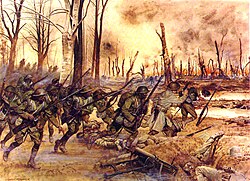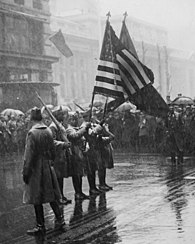
The Second Battle of the Marne was the last major German offensive on the Western Front during the First World War. The attack failed when an Allied counterattack, supported by several hundreds of tanks, overwhelmed the Germans on their right flank, inflicting severe casualties. The German defeat marked the start of the relentless Allied advance which culminated in the Armistice with Germany about 100 days later.

The Meuse–Argonne offensive was a major part of the final Allied offensive of World War I that stretched along the entire Western Front. It was fought from September 26, 1918, until the Armistice of November 11, 1918, a total of 47 days. The Meuse–Argonne offensive was the largest in United States military history, involving 1.2 million French, Siamese, and American soldiers. It is also the deadliest campaign in the history of the United States Army, resulting in over 350,000 casualties, including 28,000 German lives, 26,277 American lives and an unknown number of French lives. American losses were worsened by the inexperience of many of the troops, the tactics used during the early phases of the operation and the widespread onset of the global influenza outbreak called the "Spanish flu."
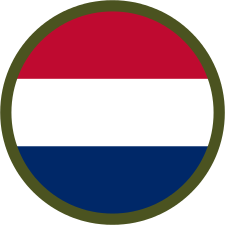
The American Expeditionary Forces (AEF) was a formation of the United States Armed Forces on the Western Front during World War I, comprised mostly of units from the U.S. Army. The AEF was established on July 5, 1917, in France under the command of then-Major General John J. Pershing. It fought alongside French Army, British Army, Canadian Army, British Indian Army, New Zealand Army and Australian Army units against the Imperial German Army. A small number of AEF troops also fought alongside Italian Army units in 1918 against the Austro-Hungarian Army. The AEF helped the French Army on the Western Front during the Aisne Offensive in the summer of 1918, and fought its major actions in the Battle of Saint-Mihiel and the Meuse-Argonne Offensive in the latter part of 1918.

The German spring offensive, or Kaiserschlacht, also known as the Ludendorff offensive, was a series of German attacks along the Western Front during the First World War, beginning on 21 March 1918. Following American entry into the war in April 1917, the Germans decided that their only remaining chance of victory was to defeat the Allies before the United States could ship soldiers across the Atlantic and fully deploy its resources. The German Army had gained a temporary advantage in numbers as nearly 50 divisions had been freed by the Russian defeat and withdrawal from the war with the Treaty of Brest-Litovsk.

The Battle of Saint-Mihiel was a major World War I battle fought from 12–15 September 1918, involving the American Expeditionary Forces (AEF) and 110,000 French troops under the command of General John J. Pershing of the United States against German positions. The U.S. Army Air Service played a significant role in this action.
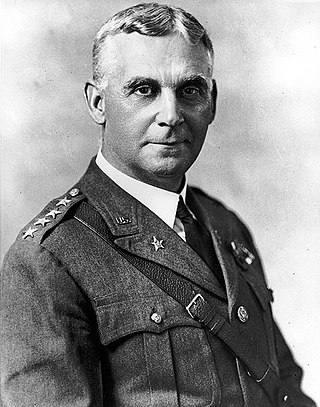
General Charles Pelot Summerall was a senior United States Army officer. He commanded the 1st Infantry Division in World War I, was Chief of Staff of the United States Army from 1926 to 1930, and was President of The Citadel between 1931 and 1953.

The Battle of Amiens, also known as the Third Battle of Picardy, was the opening phase of the Allied offensive which began on 8 August 1918, later known as the Hundred Days Offensive, that ultimately led to the end of the First World War. Allied forces advanced over 11 kilometres (7 mi) on the first day, one of the greatest advances of the war, with Gen Henry Rawlinson's British Fourth Army and Gen Marie Eugène Debeney's French First Army playing the decisive role. The battle is also notable for its effects on both sides' morale and the large number of surrendering German forces. This led Erich Ludendorff to later describe the first day of the battle as "the black day of the German Army". Amiens was one of the first major battles involving armoured warfare.
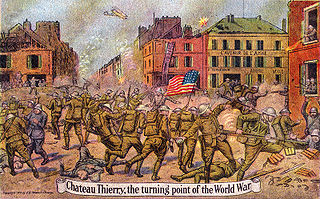
The Battle of Château-Thierry was fought on July 18, 1918 and was one of the first actions of the American Expeditionary Forces (AEF) under General John J. Pershing. It was a battle in World War I as part of the Second Battle of the Marne, initially prompted by a German Spring Offensive. German and local actions at Château-Thierry recommenced on May 31 to July 22, 1918, against the AEF, an American Expeditionary Force, consisting of troops from both the United States Army and Marine Corps units. These units were the newest troops on the front in France and just barely out of training.

The Hundred Days Offensive was a series of massive Allied offensives that ended the First World War. Beginning with the Battle of Amiens on the Western Front, the Allies pushed the Imperial German Army back, undoing its gains from the German spring offensive.

The Great Retreat, also known as the retreat from Mons, was the long withdrawal to the River Marne in August and September 1914 by the British Expeditionary Force (BEF) and the French Fifth Army. The Franco-British forces on the Western Front in the First World War had been defeated by the armies of the German Empire at the Battle of Charleroi and the Battle of Mons. A counter-offensive by the Fifth Army, with some assistance from the BEF, at the First Battle of Guise failed to end the German advance and the retreat continued over the Marne. From 5 to 12 September, the First Battle of the Marne ended the Allied retreat and forced the German armies to retire towards the Aisne River and to fight the First Battle of the Aisne (13–28 September). Reciprocal attempts to outflank the opposing armies to the north known as the Race to the Sea followed from (17 September to 17 October).

The Battle of Soissons (1918) was a battle fought on the Western Front during World War I. Waged from 18 to 22 July 1918 between the French and the German armies, the battle was part of the much larger Allied Aisne-Marne counter-offensive. It followed the final German Spring Offensive, Operation Marneschutz-Reims. The primary objective of the attack was to cut both the Soissons – Château-Thierry road and the railroad running south from Soissons to Château-Thierry. As these were the main supply routes for the German forces in the Marne salient, cutting them would severely impair the Germans' ability to supply its armies defending it. This would force them to retreat and give up their gains. This battle marked the turning point of the war as the Germans would be on the defensive for the remainder of the conflict.

Major General Charles Thomas Menoher was a U.S. Army general, first Chief of the United States Army Air Service from 1918 to 1921, and commanded the U.S. Army Hawaiian Department from 1924 to 1925.
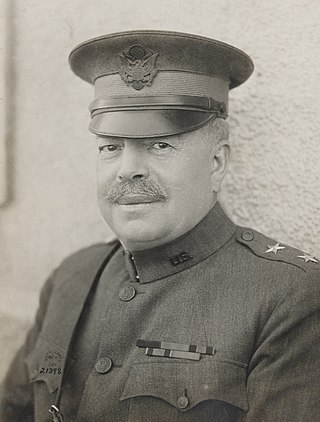
Joseph Theodore Dickman was a United States Army officer who saw service in five wars, rising to the rank of major general.

Thomas Croft Neibaur was the first Latter-day Saint (Mormon) to receive the Medal of Honor. He was also the first soldier from Idaho to be awarded the Medal of Honor. Neibaur was an automatic rifleman who served in France during World War I. On October 16, 1918, while in battle at Côté de Chatillion, while trying to eliminate a machine gun nest, Neibaur became surrounded by 15 German soldiers. With a pistol, Neibaur killed four, and captured eleven. He received six medals for his bravery and heroic exploits, as well as the Purple Heart.

The 99th Aero Squadron was an Air Service, United States Army unit that fought on the Western Front during World War I.

The 88th Aero Squadron was an Air Service, United States Army unit that fought on the Western Front during World War I.

The First Army Air Service was an Air Service, United States Army unit that fought on the Western Front during World War I as part of the Air Service, First United States Army. The First Army Air Service was the largest and most diverse Air Service combat organization of the American Expeditionary Forces in France, and most American Air Service combat units were assigned to it when assigned to the front.

This is the American Expeditionary Forces on the Western Front order of battle. The American Expeditionary Forces (AEF) consisted of the United States Armed Forces that were sent to Europe in World War I to support the Allied cause against the Central Powers. During the United States campaigns in World War I the AEF fought in France alongside French and British allied forces in the last year of the war, against Imperial German forces. Some of the troops fought alongside Italian forces in that same year, against Austro-Hungarian forces. Late in the war American units also fought in Siberia and North Russia.
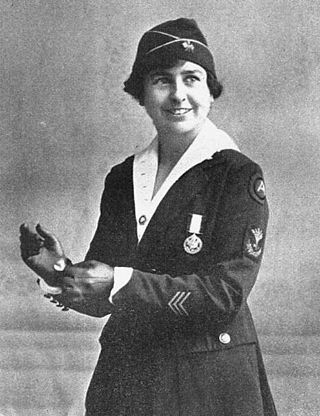
Grace D. Banker was a telephone operator who served during World War I (1917–1918) as chief operator of mobile for the American Expeditionary Forces (AEF) in the U.S. Army Signal Corps. She led thirty-three women telephone operators known popularly as Hello Girls. They were assigned in New York to travel to France to operate telephone switch boards at the war front in Paris, and at Chaumont, Haute-Marne. They also operated the telephone switch boards at First Army headquarters at Ligny-en-Barrois, about 5 miles (8.0 km) to the south of Saint-Mihiel, and later during the Meuse-Argonne Offensive. After her return to civilian life, Banker and her team members were treated as citizen volunteers and initially not given recognition as members of the military. In 1919, Banker was honoured with the Distinguished Service Medal for her services with the First Army headquarters during the St. Mihiel and Meuse-Argonne Offensives, with a commendation.



